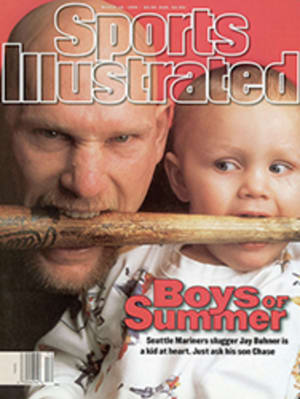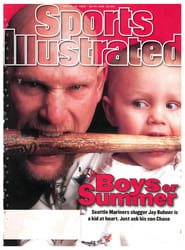
A SHOT TO REMEMBER ERNIE CALVERLEY'S BUZZER-BEATER IN THE '46 NIT WAS THE GREATEST HAIL MARY OF ALL
One of the staples of winter sports news on TV is the previous
night's most spectacular basket in a high school, college or
professional game. Usually it's a desperate one-hander flung
from beyond midcourt just before the halftime or game-ending
buzzer. But there was one virtually no-chance shot that, 50
years after it was taken, remains one of the most dramatic
baskets ever made in a pressure situation--even more thrilling
than Christian Laettner's buzzer-beater for Duke to beat
Kentucky in the East Regional final of the 1992 NCAA tournament.
In the late 1930s Rhode Island State was a little-known school
of barely 1,000 students located in the town of Kingston. Its
basketball coach was a colorful chemistry professor named Frank
Keaney. Keaney's locker-room orations often included quotes from
Socrates, Virgil, Sophocles and Shakespeare. The coach was as
flamboyant and innovative in the chemistry lab as he was on the
basketball court, and he concocted a light-blue dye that became
the school color. Known as Keaney Blue, it's still used on team
uniforms at the college, which changed its name to the
University of Rhode Island in 1951.
Keaney's greatest legacy, though, is the fast break, which he
created in the '30s, when basketball was played at a slow,
deliberate pace. Keaney's teams raced up and down the court with
abandon, scoring baskets in quantities unheard of in college
basketball. Indeed, by the 1942-43 season Rhode Island State was
averaging nearly 81 points a game, about 30 points above the
national average.
The Rams made their debut at Madison Square Garden, then the
mecca of college basketball, on Jan. 29, 1941, setting a Garden
record of 42 points in the first half of a victory over St.
Francis of Brooklyn. The crowd of almost 16,000 roared its
approval of Rhode Island State's wide-open style of play, in
contrast to the more conservative passing game that was the
norm. After the game, Ned Irish, the man who brought college
hoops to the Garden, called the Rams "the most sensational team
ever to appear in the Garden."
By 1943, a year after Ernie Calverley enrolled at Rhode Island
State, the school had fewer than 450 students and, because of
World War II, only about 100 of them were male. Calverley was a
scrawny 5'10", 130-pound guard from Pawtucket, but he was among
the nation's best players. A dazzling ball handler whose
trademark shot was a running one-hander, he was the swift
playmaker and high scorer in Keaney's run-and-gun offense.
"We ran up and down the floor and got off our shots as soon as
we could," recalls Calverley, now 72 and living in Wakefield,
R.I. "There were no set plays, and when we got the ball the
objective was to get it upcourt as fast as possible, usually
with a long one-handed pass."
Crowds delighted in watching this fast-paced new offense, but
skeptics, mostly sportswriters and basketball coaches, scoffed.
"Fire-engine" basketball, "no strategy" and "no defense" were
the most common criticisms, even though Keaney used a full-court
press as well.
With its success in competition and its immense popularity,
Rhode Island State earned four bids in the 1940s to the
eight-team National Invitation Tournament (NIT) at Madison
Square Garden. At the time the NIT was the country's most
prestigious basketball tournament, and the Rams team that
Calverley led into the '46 tournament was regarded as Keaney's
best. But even with a 19-2 record, it was given little chance
against a field that included powerhouses Kentucky and Bowling
Green. And Rhode Island State drew Bowling Green in the opening
round.
As had become the custom when the Rams played in the Garden,
nearly a thousand New Englanders, including hundreds of
students, traveled to New York aboard a Garden Special train to
watch their beloved team. At the opening tip-off Bowling Green's
6'11" All-America center, Don Otten, towered over Rhode Island
State's biggest player, 6'2" Bob Shea. But the running, gunning
Rams stayed even with the heavily favored Falcons, and with a
minute to go Rhode Island State trailed by only 72-70. With 45
seconds left Calverley swished a two-handed set shot from 35
feet to tie the game. Then Bowling Green responded with a layup
to take a two-point lead with 10 seconds remaining.
The Rams called a timeout--the rules at the time forbade players
to go to their bench, so they huddled out on the floor--and
co-captains Calverley and Shea decided that Shea would inbound
the ball to Calverley from the three-quarter mark opposite their
own foul line, and Calverley would attempt to take a desperation
shot.
"They had two guys on me, and before Shea passed the ball in I
made a move forward, then quickly retreated to throw them off,"
Calverley recalls. "Then he passed me the ball, and I took a
lunging two-hand set shot. Watching it, I didn't think it was
going to make it."
Marty Glickman, who was broadcasting the game on WHN radio,
would have agreed. "I never thought it would reach the basket,"
he says, "but it kept rising and, unbelievably, went in. It had
to be one of the most exciting moments of my career."
Though Calverley's shot had only tied the score, hundreds of
fans from the capacity crowd of 18,458 stormed the floor. When
the court was finally cleared for overtime, Rhode Island State
outscored Bowling Green 8-5 to upset the Falcons 82-79.
It was the basketball Shot Heard Round the World, and it
dominated sports pages and radio sportscasts for days. "They
measured it from the point where I shot, and it was 62 feet,"
says Calverley, who remembers that Garden officials later
painted a red X on the court to mark the spot.
New York sportswriters waxed poetic about the Rams' victory.
"This is written by one who would rather drink a Bronx cocktail
than speak well of basketball," wrote Red Smith in the Herald
Tribune. "Yet it must be confessed that there hasn't been
another sports show in years which lifted the hackles and
stirred the pulse so thoroughly as the performance of young
Ernie Calverley leading his team to an overtime conquest of
Bowling Green."
Unfortunately, no one ever saw a replay of Calverley's basket.
The camera crew shooting the game ran out of film just before
the shot and did not have time to reload.
When the Rams returned to Kingston the day after the game, they
were greeted by more than 1,000 people at the railroad station.
"They even let us out of school to go down and meet the train,"
says William Woodward, who was 13 then and would grow up to
write Keaney: If You Don't Love to Play, Pivot and Go Home!, a
biography of the beloved coach. Woodward's father, Carl, was the
president of Rhode Island State, and they went to the station
with almost the entire student body to welcome the team, which
then returned to the campus in a jubilant motorcade. Calverley
recalls, "It was like we had won the national championship."
Which, alas, they hadn't. They made it to the NIT final, against
Kentucky, and actually led at halftime, 27-26. With two minutes
left in the game the Rams still led, 45-44. But Kentucky went
ahead, 46-45, on two free throws, and Rhode Island State's dream
of a national title ended.
Despite the loss, Calverley was voted the tournament's Most
Valuable Player. And on the 50th anniversary of the first NIT,
in 1987, he was named to the alltime tournament team.
Fifty years after The Shot, people who meet Calverley still
bring it up. "They'll tell me they saw it on television," he
says, "and of course there was no television in 1946. Or they'll
say they heard it on the radio while overseas during World War
II. But the war was already over."
How significant was Calverley's shot? "It was the greatest shot
in the history of basketball," says Glickman. "No question."
Connecticut-based freelancer Jack Cavanaugh is a frequent
contributor to Sports Illustrated.
B/W PHOTO: AP After beating Bowling Green, Calverley got a big lift from Rams fans. [Fans carrying Ernie Calverley on their shoulders]
B/W PHOTO: THE PROVIDENCE JOURNAL The fast break was perfect for Calverley and his running one-handed jump shot. [Ernie Calverley in game]

